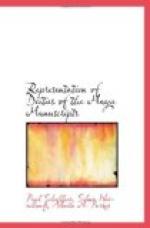The foregoing is an almost complete enumeration of the god-figures proper in the Maya manuscripts. Whatever other figures of gods occur in the manuscripts are details of slight importance. This is especially true of the Dresden manuscript, which is well nigh exhausted by the types enumerated here; there may be, I think, a few figures still undescribed in the Madrid manuscript, the careless drawing of which renders the identification very difficult. An isolated figure of the Dresden manuscript still remains to be mentioned, concerning which it is doubtful whether it is intended to represent a deity or only a human personage.
This is the figure characterized by a peculiar head ornament in Dr. 20b. It is designated in the text by two hieroglyphs, which belong together, Figs. 54 and 55, the latter occurring once with K (Dr. 7a). It seems to represent blowing from the mouth, screaming or speaking.
[Illustration: Figs. 54-55]
II. MYTHOLOGICAL ANIMALS.
1. THE MOAN BIRD.
[Illustration: Figs. 56-59]
This bird[41-1] belongs to the death-god as his symbol and attendant. Its hieroglyph (Fig. 56) contains the numeral 13; other forms are Figs. 57-59. It is pictured in Dr. 7c, 10a, 11a, 16c, 18b, and its hieroglyph without the picture is seen in Dr. 8b. A realistic representation of the whole figure of the moan as a bird, occurs on the head of the woman in 16c (1st figure) and 18b. God B sits on the head of the moan in Dr. 38c; the third hieroglyph of the accompanying text refers to this representation. Just as in Dr. 16 and 18, the moan bird appears in Tro. 18*c on the head of a woman. Its character as an attribute of the death-god is expressed by the Cimi-sign, which it wears upon its head (e. g., Dr. 10a), and also by the regular occurrence of symbols of the death-god in the written characters, which refer to the moan bird. In the same manner the sign of the owl, Fig. 5, also occurs frequently with it.
[41-1] See plate for representations
of the Mythological Animals,
1-6.
The moan confers name and symbol alike on one of the eighteen months of the Maya year, and thus, as Foerstemann conjectures (Die Plejaden bei den Mayas, in Globus, 1894), has an astronomic bearing on the constellation of the Pleiades.
According to Brinton the moan is a member of the falcon family and its zoological name is Spizaetus tyrannus.
2. THE SERPENT.
This is one of the most common and most important mythological animals, and is closely related to different deities, as has already been more fully discussed in connection with the individual cases. Apparently it has no independent significance as a deity. Its most important personification is that in god B, Kukulcan, the feathered serpent. Hence a fixed hieroglyph designating the serpent as a deity, as a




